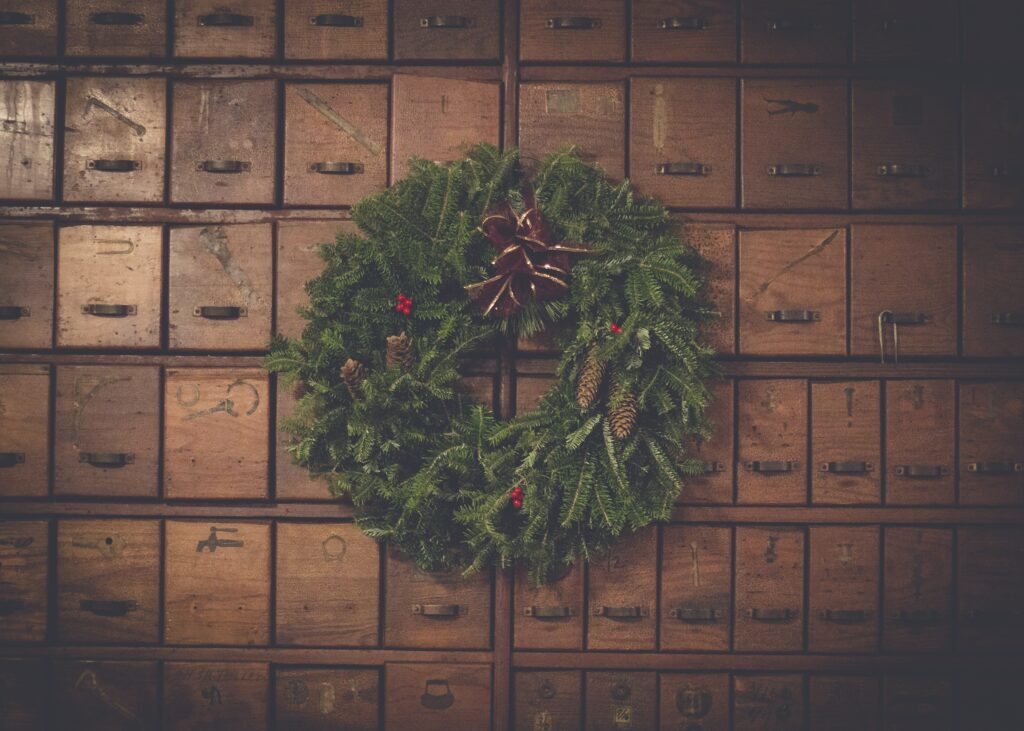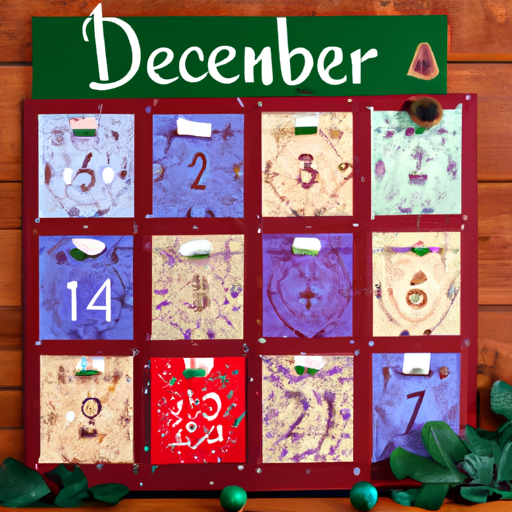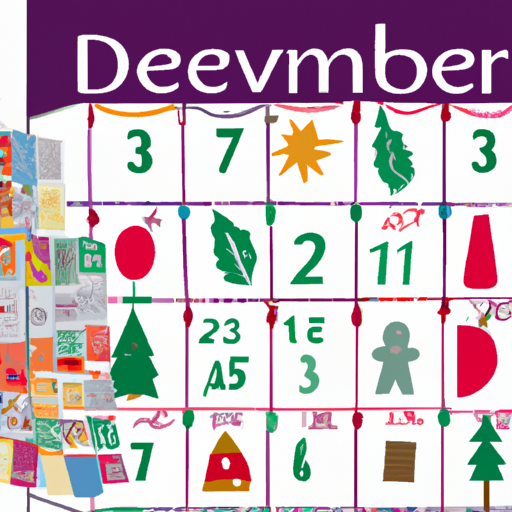
So, what are Advent Calendars?
Advent calendars have become a cherished tradition during the holiday season, eagerly anticipated by both children and adults. These special calendars provide a delightful way to countdown the days until Christmas, with a surprise waiting behind each numbered door. Whether filled with chocolates, small toys, or even beauty products, Advent calendars add an element of excitement and anticipation to the festive season.
Let’s explore the origins and popularity of these delightful calendars, and discover why they have become such a beloved holiday tradition.
History of Advent Calendars
Advent calendars have a rich history that dates back to the 19th century. Originating from German Lutherans, these calendars were initially created to help children count down the days until Christmas. Over time, the concept of advent calendars has evolved, and they have become an integral part of the holiday season for people of various cultures and beliefs.
Origin of Advent Calendars
The origin of advent calendars can be traced back to the early 19th century in Germany. Devout Christians would often mark a chalk line on their doors or light candles to count down the days until Christmas. However, in the early 1900s, Gerhard Lang, a German printer and publisher, is credited with creating the first ever printed advent calendar. Inspired by a calendar his mother used to make, Lang designed a cardboard calendar with 24 little doors, each hiding a Christmas-themed image. This innovative creation laid the foundation for the modern advent calendar as we know it today.
Evolution of Advent Calendars
From their humble beginnings as simple paper calendars, advent calendars have gone through a remarkable evolution. The first commercial advent calendars, produced by Gerhard Lang’s company, were an instant hit in Germany. Soon, their popularity spread across Europe and eventually to the United States. As time went on, different variations of advent calendars emerged, incorporating new materials, designs, and surprise elements.
Traditional Advent Calendars
Traditional advent calendars typically feature a rectangular shape with numbered doors or windows. Each door is marked with a specific date from December 1st to December 24th. As each day of the advent season passes, children excitedly open one door per day to reveal a hidden surprise or picture underneath. These surprises can range from small chocolates or candies to ornaments, small toys, or religious symbols. Traditional advent calendars serve as a fun and interactive way to build anticipation and engage in holiday festivities.
Meaning and Purpose of Advent Calendars
Advent calendars hold great significance during the period leading up to Christmas. They not only help mark the advent season, but also serve as a visual reminder of the countdown to the birth of Jesus Christ. Advent calendars encompass a range of meanings and purposes that contribute to the overall spirit of the holiday season.
The Advent Period
The period of Advent, which begins on the fourth Sunday before Christmas, is a time of spiritual reflection and preparation for the celebration of Jesus’ birth. Advent calendars play a vital role in this period by helping individuals embrace the anticipation and hope that comes with the holiday season. By counting down the days until Christmas, advent calendars serve as a daily reminder to focus on the true meaning of the holiday.
Counting Down to Christmas
One of the primary purposes of advent calendars is to provide a tangible way to count down to Christmas. By having a visual representation of the passing days, individuals can track the time remaining until the big day. This countdown heightens the excitement and joy of the holiday season, particularly for children who eagerly await the arrival of Christmas morning.
Religious Significance
For Christians, advent calendars hold a deep religious significance. The Advent season represents a time of expectant waiting and preparation for the celebration of Jesus’ birth. Advent calendars often incorporate religious imagery and symbols, such as nativity scenes, angels, or scripture verses. By engaging with these symbolic elements, individuals can deepen their connection to the spiritual aspects of Christmas.
Anticipation and Excitement
Advent calendars are a source of great anticipation and excitement, especially for children. The daily ritual of opening a door or window to reveal a surprise heightens the sense of joy and wonder in the days leading up to Christmas. This build-up of excitement fosters a festive atmosphere and creates lasting memories for individuals and families.

Types of Advent Calendars
Advent calendars come in a wide variety of types to suit various preferences and interests. From the classic chocolate calendars to more unique and themed designs, there is an advent calendar to cater to every individual’s tastes.
Traditional Chocolate Advent Calendars
Chocolate advent calendars are perhaps the most beloved and widely recognized type. These calendars feature a door or window for each day of the advent period, but instead of a picture or toy, they hide a delicious piece of chocolate. The joy of counting down to Christmas is combined with the delectable treat of a chocolate surprise each day. These calendars are particularly popular among children and chocolate enthusiasts alike.
Non-Edible Advent Calendars
In recent years, there has been a surge in the popularity of non-edible advent calendars. These calendars offer a variety of surprises other than chocolate or candies. They can include small toys, mini books, stationery, or even beauty and skincare products. Non-edible advent calendars provide a great alternative for individuals who may have dietary restrictions or simply prefer to have a non-consumable surprise each day.
DIY Advent Calendars
DIY (Do-It-Yourself) advent calendars have gained significant popularity due to their customizable nature and hands-on approach. These calendars allow individuals to create their own personalized countdown to Christmas. From crafting paper pockets or envelopes to filling them with handwritten messages, small gifts, or activities, DIY advent calendars offer a chance to unleash creativity and make the countdown truly unique.
Advent Calendars for Kids
Advent calendars specifically designed for children often feature kid-friendly themes and characters. These calendars can include toys, stickers, temporary tattoos, or small crafts for children to enjoy throughout the Advent season. Such calendars not only build excitement for Christmas but also provide an opportunity for children to engage in creative play and exploration.
Beauty and Self-Care Advent Calendars
Beauty and self-care advent calendars have gained popularity among individuals who appreciate a pampering experience during the busy holiday season. These calendars often contain mini-sized beauty or skincare products, such as face masks, nail polishes, or scented candles, allowing individuals to indulge in a daily dose of self-care. Beauty and self-care advent calendars combine the joy of counting down to Christmas with a touch of luxury and relaxation.
Alcohol and Beverage Advent Calendars
For those who want to add a spirited touch to their advent countdown, alcohol and beverage advent calendars offer a delightful surprise each day. These calendars can contain miniature bottles of different alcoholic beverages, such as whiskey, gin, or wine, allowing individuals to enjoy a beverage tasting experience throughout the advent season. Additionally, non-alcoholic beverage advent calendars, such as coffee or tea-themed calendars, provide a daily treat for individuals who prefer a warm and comforting drink.
Key Features and Design
When choosing an advent calendar, several key features and design elements should be taken into consideration. These aspects contribute to the overall experience and usability of the calendar.
Number of Days
Traditionally, advent calendars cover a span of 24 days, starting on December 1st and ending on Christmas Eve, which is on December 24th. However, some calendars may include an additional day or deviate from this standard timeframe. It is essential to check the number of days specified on the calendar to ensure it aligns with personal preferences and traditions.
Windows or Pockets
The design of an advent calendar often includes either numbered windows or pockets representing each day of the advent period. Windows are typically made of paper or cardboard and can be opened to reveal a surprise underneath. Pockets, on the other hand, are often fabric or felt and can hold small items or treats. Choosing between windows or pockets depends on personal preference and desired interaction with the calendar.
Illustrations and Artwork
The visual appeal of an advent calendar plays a significant role in its overall charm. Calendars can feature colorful illustrations, holiday-themed artwork, or festive designs that reflect the spirit of Christmas. The choice of illustrations and artwork can vary from traditional Christmas symbols, such as snowflakes or stockings, to modern or personalized designs. Opting for a calendar with artwork that resonates with personal style and preferences can enhance the joy of using an advent calendar.
Materials and Construction
The materials used in the construction of an advent calendar can vary depending on the type and design. Advent calendars can be made from paper, cardboard, fabric, felt, or even plastic. Assessing the durability and quality of the materials is important, especially for reusable calendars that are meant to be enjoyed year after year. Exploring different materials allows individuals to choose a calendar that aligns with their preferences and fits well with the intended purpose.
Size and Dimensions
Advent calendars come in various sizes and dimensions, ranging from compact options to larger displays. Consider the available space for the calendar and whether it will be placed on a wall, countertop, or any other designated area. Smaller calendars may be more suitable for individuals with limited space, while larger calendars can create an eye-catching centerpiece. Choosing the appropriate size ensures that the advent calendar fits seamlessly into the holiday decor.
Reusability
Some advent calendars are designed for single use, where the doors or pockets are sealed or torn open once the corresponding day arrives. Other calendars can be reused year after year, allowing individuals to enjoy the countdown to Christmas season after season. Reusable advent calendars often involve reusable materials or concealed compartments that can be refilled and reassembled each year. Considering the longevity and sustainability of a calendar can help promote environmentally friendly practices and provide continued enjoyment.
Interactive and Digital Advent Calendars
With the advent of technology, digital advent calendars have become increasingly popular. These calendars offer an immersive and interactive experience through mobile apps or online platforms. Digital advent calendars can include multimedia content, such as videos, games, or puzzles, and allow for personalized customization. While these calendars may lack the tactile element of traditional versions, they provide a modern twist on the advent calendar tradition and can be easily accessed on digital devices.

Popular Themes and Designs
Advent calendars come in a wide range of themes and designs, allowing individuals to select one that resonates with their personal interests and preferences. These themes and designs contribute to the overall excitement and joy of the advent season.
Traditional Christmas Symbols
Many advent calendars incorporate traditional Christmas symbols to evoke a sense of nostalgia and familiarity. These symbols can include images of Santa Claus, reindeer, snowmen, gingerbread houses, or Christmas trees. By featuring these timeless symbols, advent calendars connect individuals to the festive traditions and customs associated with Christmas.
Popular Characters and Themes
Advent calendars featuring popular characters from movies, cartoons, or books have gained immense popularity, particularly among children. Characters like Mickey Mouse, Paw Patrol, Barbie, or Harry Potter can be found on advent calendars, adding an element of fun and familiarity to the countdown. Choosing a calendar featuring a favorite character or theme allows individuals to celebrate the holiday season with beloved icons.
Personalized Advent Calendars
Personalized advent calendars offer a unique way to make the countdown to Christmas more special. These calendars can be customized with names, photos, or personal messages, adding a personal touch to the festive season. Whether it’s a calendar featuring personalized family portraits or message-filled envelopes, personalized advent calendars make the countdown truly one-of-a-kind and meaningful.
Novelty and Unique Designs
For individuals seeking something different, novelty and unique designs provide an exciting alternative. Advent calendars can come in unconventional shapes, like Christmas stockings or matchboxes, and incorporate innovative surprises or unconventional materials. These creative designs add an element of surprise and intrigue to the advent season and can be a great conversation starter.
Benefits of Using Advent Calendars
Beyond their role as a festive tradition, advent calendars offer a range of benefits that enhance the holiday experience. Whether used individually or shared within a family setting, advent calendars have a positive impact on individuals of all ages.
Encourages Daily Reflection
Advent calendars prompt individuals to take a moment each day to reflect on the passing of time and the approaching Christmas celebration. It serves as a daily reminder to slow down, appreciate the present moment, and find joy in the anticipation of what is to come. The ritual of opening a door or pocket each day can cultivate mindfulness and gratitude, fostering a deeper connection with the holiday season.
Teaches Patience and Delayed Gratification
Counting down to Christmas through an advent calendar helps instill patience and delayed gratification in individuals. As each day passes, the wait for Christmas becomes a lesson in self-control and the ability to savor anticipation. Children, in particular, benefit from this experience as they learn to manage their expectations and understand that good things come to those who wait.
Builds Excitement and Festive Spirit
The daily unveiling of surprises or treats from an advent calendar fosters a sense of excitement and joy throughout the advent season. Whether it’s the anticipation of opening the next door or the thrill of discovering a hidden surprise, advent calendars infuse the holiday season with a festive spirit. The countdown to Christmas becomes a shared experience that brings people together and creates lasting memories.
Enhances Family Bonding
Advent calendars can strengthen family bonds as they encourage shared excitement and engagement. Opening doors or pockets together each day becomes a joyful family ritual that builds anticipation for Christmas. It creates opportunities for families to spend quality time together, fostering a sense of togetherness and unity. Advent calendars serve as a reminder of the importance of family in celebrating the holiday season.
Offers Surprises and Variety
The element of surprise that advent calendars bring adds an element of delight to the holiday season. Each day holds a new surprise, whether it’s a piece of chocolate, a small toy, or a hidden message. This variety keeps the countdown engaging and ensures that every day brings a touch of excitement. Advent calendars offer a welcome break from the usual routine, injecting a sense of wonder and surprise into the daily routine.
Promotes Creativity and DIY Projects
DIY advent calendars promote creativity and provide opportunities for hands-on engagement. Creating personalized calendars involves brainstorming unique ideas for fillings, designing and crafting compartments, and choosing themes or artwork. This process fosters creativity and allows individuals to express their personal style throughout the advent season. DIY advent calendars also encourage the exploration of artistic skills and can even become a bonding activity for friends and family.

Creative Ideas for Advent Calendars
Advent calendars can be customized in myriad ways to add a personal touch and tailor the experience to individual tastes. Here are some creative ideas to take advent calendars to the next level:
Fillings and Treat Ideas
Instead of traditional chocolates or candies, consider unique fillings and treats for each day of the advent season. These can include homemade cookies, small handmade crafts, mini puzzles, or even acts of kindness to be performed each day. Choosing meaningful and personalized treats adds an extra layer of thoughtfulness to the advent calendar experience.
Alternative Countdown Methods
While most advent calendars follow a daily countdown, alternative methods can offer a twist on tradition. For instance, countdown calendars can feature weekly surprises instead of daily ones, creating a longer anticipation for each surprise. Another alternative is a reverse countdown calendar, where doors are opened from December 24th to December 1st, adding a sense of excitement by starting with the biggest surprise.
Themed Advent Calendars
Themed advent calendars cater to specific interests and passions, making the countdown experience more tailored and exciting. Whether it’s a sports-themed calendar featuring items related to a favorite team or a crafting-themed calendar with daily craft supplies, themed calendars provide an opportunity to celebrate individual hobbies and interests throughout the advent season.
Collaborative Advent Calendars
Collaborative advent calendars can be a wonderful way to involve multiple individuals in the advent countdown. This can be done by creating a shared calendar where each person contributes a surprise or by taking turns opening doors or pockets. Collaborative calendars emphasize the spirit of togetherness and create memorable moments to cherish.
Cultural Significance of Advent Calendars
The cultural significance of advent calendars extends beyond the festive season and holds a special place in various traditions and celebrations worldwide.
Celebration in Christian Traditions
In Christian traditions, advent calendars are an integral part of the observance of Advent, a period of preparation and waiting for the birth of Jesus Christ. The calendar serves as a visual reminder of the anticipation and hope associated with this period. Advent calendars often incorporate religious imagery, such as nativity scenes or scripture verses, providing a daily reflection on the significance of Christ’s birth.
Advent Calendars Worldwide
Advent calendars have gained popularity worldwide and are celebrated by individuals of various cultures and religions. While their origins may be rooted in Christian traditions, their appeal has transcended religious boundaries. Advent calendars are now embraced by people from diverse backgrounds who appreciate the joy and excitement associated with the countdown to Christmas.
Advent Calendar Traditions over Time
As advent calendars evolved over time, customs associated with their use have developed as well. Some families use their advent calendar as an opportunity to perform acts of kindness or engage in charitable activities, reinforcing the spirit of giving during the holiday season. Others may incorporate storytelling or daily readings into the advent calendar ritual, deepening the understanding of the Christmas narrative. These traditions vary across different cultures, allowing individuals to personalize the advent calendar experience.

Popular Brands and Products
With the increasing popularity of advent calendars, various brands have emerged, offering a wide range of options to suit different preferences and budgets.
Leading Advent Calendar Brands
Some of the leading advent calendar brands include Cadbury, Lindt, LEGO, Playmobil, and Yankee Candle. These renowned brands are known for their high-quality products and innovative designs, ensuring a memorable advent season.
High-End and Luxury Advent Calendars
For those seeking a touch of luxury, high-end and luxury advent calendars are available. These calendars feature premium products from prestigious brands in fields such as beauty, skincare, or fine beverages. High-quality ingredients, exquisite packaging, and limited-edition items are often included in these calendars, transforming the countdown into a truly indulgent experience.
Creative and Unconventional Advent Calendars
In recent years, creative and unconventional advent calendars have gained popularity, offering unique alternatives to traditional options. Brands now produce calendars featuring items like socks, hot sauces, stationery, or even miniature figurines. These calendars cater to niche interests and provide unexpected surprises each day of the advent season.
Environmental Considerations
As society becomes increasingly aware of environmental concerns, it is essential to consider the sustainability and eco-friendly aspects of advent calendars.
Sustainable and Eco-Friendly Advent Calendars
Many brands now offer sustainable advent calendars made from recycled materials or eco-friendly alternatives, reducing the carbon footprint associated with their production. These calendars are designed to be reusable or recyclable, promoting sustainability and reducing waste.
Reducing Waste and Packaging
Efforts to reduce waste and excessive packaging have led to the development of advent calendars that emphasize minimalism and eco-consciousness. Some brands explore innovative packaging techniques, such as compostable or biodegradable materials, or utilize minimal packaging to reduce environmental impact. By choosing advent calendars with reduced waste and packaging, individuals can contribute to a more sustainable holiday season.
Upcycling and Repurposing Advent Calendars
To further promote sustainability, advent calendars can be upcycled or repurposed after the advent season ends. By transforming the calendar into a decorative item, storage solution, or even a festive display for future holiday seasons, individuals extend the lifespan of the advent calendar and reduce unnecessary waste. Repurposing advent calendars encourages creativity and environmental responsibility.
In conclusion, the history, meaning, and purpose of advent calendars have transformed them into an integral part of the holiday season. From their origins in 19th-century Germany to their global popularity today, advent calendars bring joy, excitement, and reflection to individuals of all ages. With a wide range of types, designs, and themes available, advent calendars offer a customizable and diverse countdown experience. Not only do they build anticipation and foster family bonding, but they also provide opportunities for creativity and self-expression. As we celebrate the advent season, let us embrace advent calendars as a means to reflect on the true meaning of Christmas, create lasting memories, and promote sustainability and joy in our communities.

